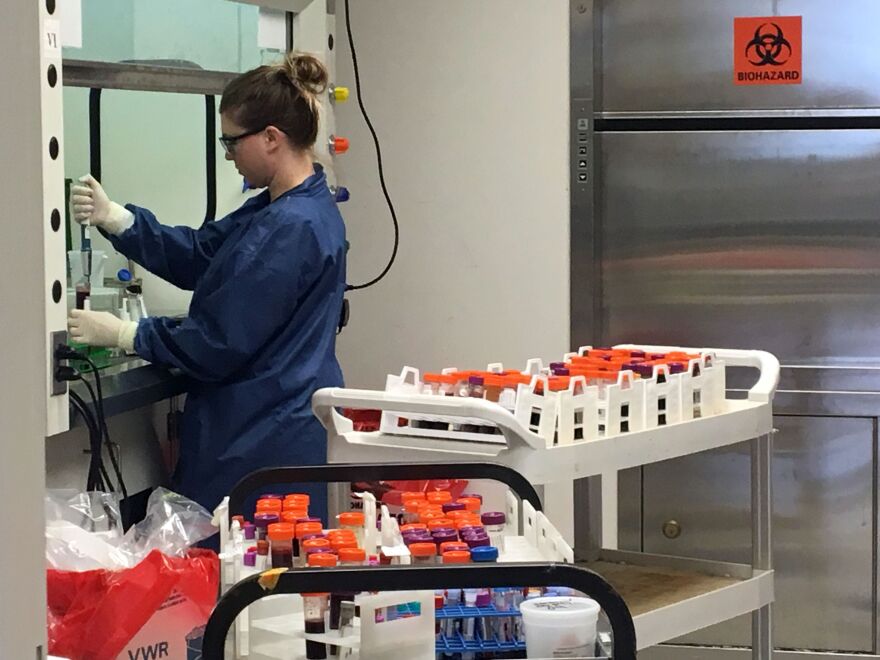The standard narrative about the opioid crisis is one you probably know well. In many cases patients got hooked on prescription pills, and escalated toward heroin and synthetic killers like fentanyl.
But there isn't just one path to addiction in this crisis.
Mixtures of opioids with drugs like cocaine, and a spike in deaths especially among African-Americans has officials worried the crisis could get much worse.
“People have to know that drugs don’t have a race. Drugs don’t discriminate,” says Jessica Horne, executive director of UMADAOP--a long acronym for Urban Minority Alcoholism Drug Abuse Program.
“…which is why we call it UMADAOP,” Horne chuckles.
She sits in a computer lab in an old library on Cleveland’s east side, which now serves as her office. Horne spreads the word about drug prevention, and offers techniques and programs to help people stay out of trouble.
There’s a good chance that a lot of the information you’ve heard about the ‘opioid crisis’ at-large has reinforced an idea that the crisis is hitting large numbers of white victims.
And it is.
But that’s not all.
“If you look at the media the new face of addiction is white," Horne says. "We took a flyer out that the signs were everywhere. And there was a guy standing on the corner and I handed him the flyer and he said, ‘what you giving that to me…that ain’t none of our problem.’ And I was like, wow.”
Fentanyl is a powerful, synthentic opioid now being mixed with heroin, with cocaine, with methamphetamine. But in many cases people don’t know they’re taking fentanyl, and Horne says there’s no honor among dealers to say something.
“It became very clear they’re lacing cocaine with fentanyl," she says. "So we said well why, why are they doing that? And the reason that they’re doing it is because first of all, it’s highly addictive. A person could basically maybe take it one or two times and have a jones for it.”
That is if they don’t die first, and many users are dying.
Horne says in 2016 there were about 57 African-Americans who died from cocaine and fentanyl.
"When we looked at right in the beginning of 2017, it was like we surpassed that in almost three months,” she says.
Deaths related to cocaine in Cuyahoga County have been fairly stable historically, about 100 to 120 cases a year, according to the Medical Examiner’s office.
Hugh Shannon is the administrator at that office, and he says fentanyl is cheap, and it’s created by just mixing chemicals in a lab.
Authorities have since identified China as a major source for synthetic opioids, creating a perfect storm for fatalities.
“2015 the numbers went up, 2016 they exploded—we went from 90 to 400," Shannon says. "In 2016 with that much fentanyl, it did start spilling over into the cocaine supply. The cocaine deaths went up—we were at like 125, and it shot up to like 260 in 2016. When you take fentanyl out of the mix, the number of cocaine deaths didn’t change, it was about 130. But it doubled when you added the mixture of cocaine and fentanyl.”
Shannon says the number of fentanyl deaths among African-Americans was a fraction of total deaths in the crisis at first, say 50 of 400, so the threat could be buried to people not watching trend lines closely.
But the Medical Examiner’s office under Dr. Thomas Gilson has been watching.
“So 2017 saw really just the full integration of fentanyl into the cocaine supply. It definitely was as prevalent as heroin was, and I think if you look at the numbers when it’s all said 2017 will have an equal number of folks who died with both heroin and fentanyl in their system, and cocaine and fentanyl in their system,” Shannon says.
Cuyahoga County’s Medical Examiner has a full laboratory analyzing evidence collected in the field, and a toxicology lab reviewing blood and other samples from victims. It's an expansive facility, allowing scientists to compare notes at various stages of investigations.
The potency of synthetic opioids has prompted this lab to keep fans for venting fumes on all the time, along with scientists wearing gloves and masks, etc.
“With the volume of cases that we’re operating under right now with the crisis, I think we’ve gone from about 9 or 10 thousand to 25 thousand samples that get analyzed in this lab every year. So that’s a substantial increase,” Shannon says.
It’s through a thorough analysis, and comparing samples between drug chemistry and toxicology, that the Medical Examiner discovered fentanyl mixed in with drugs like cocaine.
It was another evolution in the crisis.
“It’s actually such a problem that I’ve stopped talking about there being an opioid crisis, and I speak more generally about there being a narcotics overdose crisis," says Justin Herdman, the U.S. Attorney for the Northern District of Ohio.
"What is really driving our death rate up is fentanyl," he says. "There’s a lot of other associated mixtures that are in-play, but fentanyl is what has increased our death rate at least in the Northern District of Ohio significantly since 2015. And the source of fentanyl is predominately through the mail, it’s predominately purchased via the Dark Web and using cryptocurrencies, and we have to be ever vigilant of that. It is a different distribution system that we’ve dealt with in the past. We have to attack it differently. And we’ve got to be very flexible on the law enforcement standpoint in dealing with it.”
Herdman says awareness is number one in this drug epidemic, that whatever people think they’re buying on the street, is not what a dealer says it is.
So enforcement, but also increasing education, outreach, treatment, are all parts of addressing the crisis.
Full Interview With U.S Attorney Justin Herdman
“We are committed to solving this crisis in any way we can," Herdman says. "We have to be thoughtful about it, we have to be broad in our approach. And our number one guiding principle is we have to save as many lives as we can. It’s not something you typically hear from a prosecutor, but that’s the reality, is that our death rates are beyond a crisis level.”
“I’m gonna say we learned a lot of lessons from the cocaine epidemic,” says Jessica Horne, the prevention outreach worker. “And so I’m gonna say that the lessons that we learned are the reasons now that we’re not using this as a criminal piece, that we’re having compassion, that we’re trying to get people to treatment, and those kinds of things.”
Horne is reluctant to more directly talk about the role race may be playing in how our society is dealing with the opioid crisis. "There's too many people dying for that," she says repeatedly.
But I asked what would be needed in this crisis or others to change how we look at the victims. If the opioid crisis is seen as a “white problem” by a lot of people in the community, whereas the crack cocaine epidemic was dubbed a “black problem,” I asked what do she thinks needs to happen to address this as a people problem, and we just say people are dying, citizens are dying, people in our bigger community are dying?
“We do get caught up in ‘the drug,’" she says, thoughtfully. "I think that we have to get to the point where we look at, in America, we have a drug problem. If we stopped fentanyl from coming into the country illegally tomorrow, we’d find something else.”
Jessica Horne says there are deeper issues that should be dealt with to truly impact the drug epidemic. She says our society impresses on us that there is a solution to our stress, pain, trouble, outside of us.
There’s a pill for that.
There’s an app for that.
But she thinks part of the solution is strengthening community social support, especially for young people.
She says houses may look fine on the outside, in the city or the suburbs, but inside there could be figurative fires—or crises—raging.
The key is to learn to live in the fire and not burn up…and find a way out.








